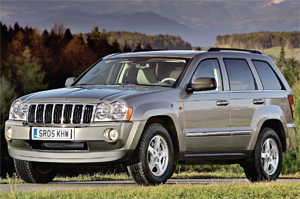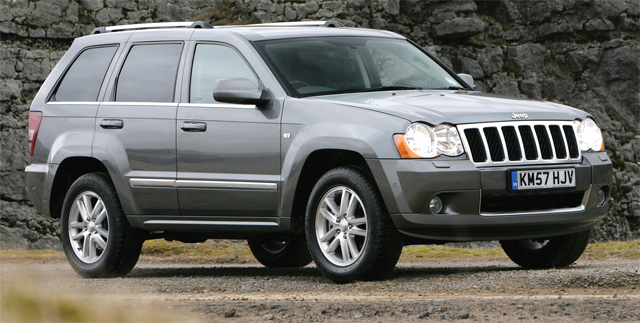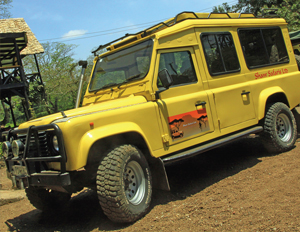Bold styling and enhanced refinement for the 2005 model year made the Grand Cherokee a more suitable competitor in the crowded luxury SUV sector – with the added appeal of heavy depreciation making it a particularly good-value second-hand purchase
 TARGET RANGE: £5000 – £15,000
TARGET RANGE: £5000 – £15,000
When the Jeep Grand Cherokee first appeared here in 1994 it was a clear declaration of Chrysler’s intent to expand into new markets, particularly in Europe where the marque was hardly known. The car was deliberately designed to appeal to a more discerning European clientele, shrugging off the boxy truck-like styling of earlier Jeep SUVs and offering more mechanical refinement and ride comfort than was the rugged norm in its home market. It was quite an advanced design for an American SUV at the time, since it did away with the concept of a separate steel chassis opting instead for a monocoque bodyshell, although the floorpan was reinforced to such an extent that Jeep engineers claimed it was stiffer and stronger than a chassis-based 4×4. It did, however, retain rigid axles front and rear, sprung on coils. It quickly became apparent that in spite of its sleek outward appearance the first generation Grand Cherokee still lacked the levels of luxurious refinement exhibited by its major British and Eastern rivals, so the Jeep gained limited acceptance more for its good-value pricing than for its aesthetic qualities, while the 4.0-litre petrol engine was thirsty and the 2.5-litre VM turbodiesel offered in later examples was rough and underpowered. The updated model for 1999 had a more pleasing interior, but suffered from having a no-win choice of lively but thirsty petrol V8 or dull-performing turbodiesel engines. For the 2005 model year Chrysler got it almost right, the completely revised Grand displaying a bolder front end and a more stylishly sculpted interior, along with a smooth-revving 3.0-litre Mercedes CRD turbodiesel as the mainstream power source. For those who craved the typical American power of a big petrol V8 the legendary Chrysler Hemi in 5.7-litre form was offered as an alternative for the first year, some early versions also had the 4.7-litre V8, but the weak demand for these is reflected in the second-hand marketplace where the turbodiesel predominates.

One reason for the improved refinement of the third generation car was the adoption of independent front suspension, good news as far as urban users more interested in on-road comfort are concerned, not so exciting a development for anyone looking to enjoy the Jeep as an off-road plaything, where the previous model, with its rigid axles front and rear, is patently more proficient and easier to adapt for hard-core off-roading. Even so, mechanical upgrades in the new model included the Quadra-Drive II system, which effectively provides auto-engaging centre and axle differential locks so the Grand should continue to move even if only one wheel has traction. The switch to independent front suspension did also allow the traditional recirculating ball steering mechanism to be replaced by a rack and pinion system, instantly giving the big SUV a crisper steering feel with more positive feedback. This generation also saw the introduction of an electronic stability programme including traction control and a ‘rollover mitigation’ feature that steadies the car in a corner taken too quickly. Transmission in all models is a five-speed automatic, and four-wheel drive is permanent with selectable low range. The interior of this generation is more heavily sculpted than in previous models, aimed at giving the car a more substantial feel, though some might find the heaviness of the dash and the chunkiness of the centre console to be a little overpowering. In fact the seats are comfortable, the rear bench has a 60/40 split facility and the boot is capacious, making it an ideal car for an adventurous family, a fact enhanced by good-value second-hand pricing, even though this may have been driven by the temporary lull in sales and service activity in the years before the Jeep brand found new support from Fiat.
 To read the full report see the July 2014 issue of 4×4 Magazine. Buy it here
To read the full report see the July 2014 issue of 4×4 Magazine. Buy it here

